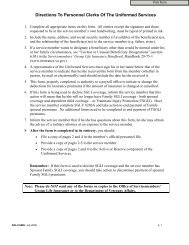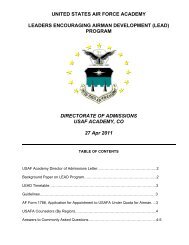USAFA - United States Air Force Academy
USAFA - United States Air Force Academy
USAFA - United States Air Force Academy
You also want an ePaper? Increase the reach of your titles
YUMPU automatically turns print PDFs into web optimized ePapers that Google loves.
Helicopter Pilot<br />
<strong>Air</strong> <strong>Force</strong> helicopter pilots are an important and integral part of the <strong>Air</strong> <strong>Force</strong>’s world-class flying team. As a helicopter pilot,<br />
you’ll operate rotary wing aircraft and command crews to accomplish combat and training missions. Mission planning— reviewing<br />
mission tasking, intelligence/weather information, and supervising mission preparations are your responsibility. During missions<br />
you’ll operate aircraft controls and equipment and supervise or direct navigation activities. You’ll also oversee in-flight refueling<br />
and weapon delivery. You are responsible for overall operational readiness by conducting or supervising mission-specific<br />
crewmember training.<br />
Reconnaissance/surveillance/electronic Warfare Pilot<br />
This is a high security assignment requiring quick thinking, cool nerves, and a lot of highly specialized training. As a select<br />
member of the <strong>Air</strong> <strong>Force</strong> team you might perform reconnaissance, surveillance, search and rescue, or electronic combat missions.<br />
Mission preparations include reviewing mission tasking, intelligence/weather information, mission and flight planning, and crew<br />
briefings. You’ll navigate aircraft using available navigation systems, and conduct and supervise crewmember training.<br />
Special Operations Pilot<br />
In this career you’ll receive specialized training as you learn to fly special operations aircraft (either fixed-wing or helicopter).<br />
You’ll be in command of aircraft and crew while completing special operations and training missions. Reviewing mission<br />
tasking, intelligence/weather information, supervising preparations and planning and conducting crew briefings are additional<br />
responsibilities. During flights you’ll operate aircraft controls and direct/ supervise navigation, oversee in-flight refueling<br />
operations, reconnaissance, weapons delivery, and conduct specialized crewmember training.<br />
Tanker Pilot<br />
Readiness and effectiveness of every <strong>Air</strong> <strong>Force</strong> squadron rely on the talents and expertise of tanker pilots. As a tanker pilot you’ll<br />
review mission tasking, intelligence/weather information, supervise preparations and planning as well as conduct crew briefings.<br />
During flights you’ll operate aircraft controls, direct or supervise navigation, ensure proper weapons delivery and supervise<br />
crewmember training.<br />
Astronaut<br />
Astronauts command space shuttle missions, pilot space shuttles, perform on-orbit duties, and provide manned space<br />
flight consultation. Commanding space shuttle missions requires operation of all shuttle vehicle systems and supervision of<br />
crewmembers. You’ll be an integral part of onboard flight operations. As an astronaut you’ll operate and reconfigure orbiter<br />
systems, monitor payload/shuttle interface, and perform extra-vehicular activities to make repairs, refurbish/inspect satellites in<br />
orbit or in the payload bay.<br />
Officers who serve as doctors and legal officers are not included here because their assignment depends on academic qualifications<br />
completed after graduation from the <strong>Academy</strong>. But, some graduates do serve in these specialties. Other <strong>Air</strong> <strong>Force</strong> members may<br />
serve in one of four non-flying categories.<br />
<strong>Air</strong> Weapons Controller<br />
Officers in air weapons control handle the interception of hostile aircraft and missiles. As an air weapons control officer you<br />
may fly as a crewmember on an <strong>Air</strong>borne Warning and Control System (AWACS) aircraft. You’ll use the sophisticated AWACS<br />
equipment to see and identify airborne objects. Or, you may work with ground mobile and fixed radar. You’ll also electronically<br />
jam hostile radar and communications.<br />
Operations Management<br />
As an operations management officer, you’ll plan and coordinate weapons and other combat resources for use. You’ll oversee<br />
installation of communications equipment required to keep an air base operational while it is under attack and plan tactical<br />
deceptions to confuse the enemy.<br />
You’ll get excellent leadership and administrative experience working with U.S. and foreign forces. You’ll operate command posts,<br />
implement higher headquarters policy, plan and analyze training programs to ensure people are prepared to do their jobs safely<br />
and correctly.<br />
<strong>Air</strong> Traffic Controller<br />
Officers in air traffic control oversee aircraft takeoffs and landings by supervising centers covering radar approach, air route<br />
traffic, ground control approach, and air base towers. You’ll oversee air traffic flying operations and systems; you’ll serve as a staff<br />
officer on matters concerning air traffic control; and you’ll advise flying units on air traffic control support.<br />
43 <strong>United</strong> <strong>States</strong> <strong>Air</strong> <strong>Force</strong> <strong>Academy</strong> Catalog




